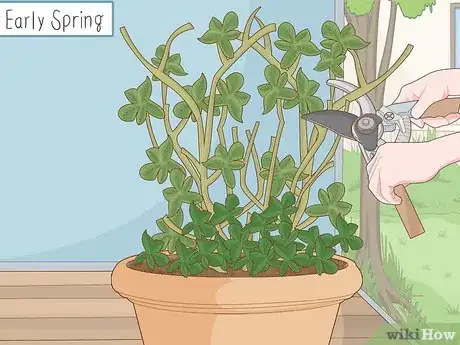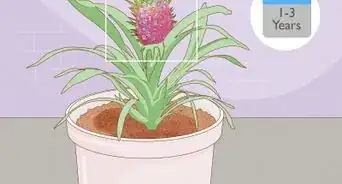This article was co-authored by wikiHow Staff. Our trained team of editors and researchers validate articles for accuracy and comprehensiveness. wikiHow's Content Management Team carefully monitors the work from our editorial staff to ensure that each article is backed by trusted research and meets our high quality standards.
There are 8 references cited in this article, which can be found at the bottom of the page.
This article has been viewed 36,856 times.
Learn more...
Although blueberry bushes are commonly grown outdoors, smaller varieties grow very well in pots. Potted blueberries don’t require a ton of maintenance, but they do have some specific needs to be aware of. Set bushes in acidic soil, then maintain the moisture level with frequent watering. Blueberry bushes produce fresh fruit after 3 to 4 years of growth. If you enjoy fresh blueberries, caring for your own blueberry bushes can be a rewarding experience.
Steps
Selecting and Potting a Bush
-
1Pick a compact variety that fits well in pots. Dwarf plants produce plenty of blueberries without taking up much space. Some of the most common varieties for pot growing include Top Hat and Sunshine Blue. Other types, such as the northern highbush blueberry, do better in the ground but can survive in pots with proper care.[1]
- Look for young blueberry plants at a local nursery in the beginning of spring. Chances are you will find some that grow well in your area. If you can’t find any, try ordering some from an online nursery.
-
2Choose a blueberry variety best suited to the weather in your area. Blueberry plants are pretty hardy but still struggle to survive in the wrong environment. Before settling on a variety to keep at home, research the kind of climate it grows in naturally. In particular, keep in mind the extreme temperatures in your region.[2]
- For instance, Top Hat bushes grow best in climates that experience minimum temperatures no lower than −50 °F (−46 °C).
- Sunshine Blue bushes do best in slightly warmer climates with a minimum average temperature no lower than about {−20 °F (−29 °C).
- You can grow blueberries indoors. As long as you put them in a sunny spot with good temperature control, you may be able to keep varieties not usually suited to your region.
Advertisement -
3Pick a deep container at least 12 in (30 cm) wide. Start off with a pot that is about the same size as the plant. A 12 in (30 cm) pot is good for most young blueberry bushes, but use something wider if the bush crowds up against the pot’s edges. The starting pot you choose will last your blueberry bush 2 to 3 years on average. Make sure you choose a well-draining pot with drainage holes in its bottom.[3]
- Pots from 20 to 24 in (51 to 61 cm) in diameter are better for blueberry bushes a few years old.
- The type of pot you use doesn’t matter much and is up to your personal preference. Terracotta pots drain well and are a good choice if you tend to overwater plants. Plastic pots are stronger and retain more moisture, meaning less frequent watering.
-
4Fill the pot with an acidic potting mix. Blueberries grow best in acidic soil, so look for an acidic potting mix at your local garden center. Try using a bagged mix meant for hydrangeas and azaleas. The average pH blueberries need is between 4.5 and 5.5. Check the label on the potting mix to make sure it’s acidic enough for blueberry bushes.[4]
- Another way to make a mix is to combine equal amounts of regular potting soil and peat moss.
- You can also make your own mix using other ingredients, such as equal amounts of peat moss, pine bark, and sand.
-
5Tip over the blueberry bush to slide it out of its old pot. The plants come in small growing containers. After you get the bush home, remove it from the container without damaging the roots. Tap on the back of the container as needed to loosen the dirt. If it doesn’t slide out, gently pry out the dirt clod with a dull knife or a similar object.[5]
- Use your free hand to support the plant’s stem so it doesn’t fall or bend.
-
6Loosen some of the roots in the bottom of the dirt ball. After you pull the plant out of the container, start removing dirt from the bottom of the dirt ball. Feel for the roots close to the outer edges. Gently pull some of the roots out to expose them. This causes the roots to expand outward in the new soil instead of staying in a small ball.[6]
- If you don’t loosen the roots, they won’t expand out of the dirt ball and your plant won’t expand.
-
7Center the blueberry plant in the pot and bury it up to its crown. Make sure the crown, the part of the stem right above the dirt ball, is almost level with the top of your planter. Shift some of the soil mix around as needed to position the plant. Smooth out the dirt with your hands, then water it thoroughly until it feels moist to the touch.[7]
- Burying the crown essentially means burying your plant. The plant won’t survive, so you won’t get any blueberries.
Developing Blueberries
-
1Place the plant in an area that receives at least 6 hours of sunlight a day. The more sunlight you give a blueberry plant, the better off it will be. Blueberry plants are usually grown outdoors for this reason, but you can also grow a potted bush indoors if you have space for it. Watch your home throughout the day to see which spots stay sunny.[8]
- Blueberry bushes may survive in partial shade, but keep in mind that too much shade leads to smaller, weaker berries.
- The exception to full sunlight is in very hot weather, especially in the middle of the afternoon. You may wish to move the bushes into a shady area to prevent them from drying out.
-
2Add up to 2 in (5.1 cm) of water per week. Blueberry plants are sensitive to soil moisture levels. Touch the soil often to make sure it feels moist about 2 in (5.1 cm) deep. If the soil feels wet or soggy, hold back on the water until the soil dries up again. For the best results, water your bushes frequently but lightly several times a week.[9]
- If you can, use rainwater on your blueberries. Rainwater has less of an effect on the soil pH than tap water.
- Drip irrigation is a great way to maintain the soil’s moisture level. For example, use a plastic bottle with a hole in it to slowly leak water into the soil.
-
3Cover the soil with a 2 in (5.1 cm) layer of mulch. The best type of mulch to use is pine needles, pine wood, or chipped hardwood bark. These mulches are acidic, keeping the soil pH low for blueberry bushes to thrive. Mulch also insulates your plants, reducing stress from heat and water loss.[10]
- Spread mulch as soon as possible after potting a blueberry bush. Mulch is useful all year, but it is especially beneficial during summer.
-
4Spread an organic fertilizer 4 to 6 weeks after planting the blueberry. For the best results, get an acidic slow-release fertilizer. Any fertilizers made for acidic soil plants like hydrangeas and azaleas are also great for blueberries. Slow-release fertilizers give blueberries a continual boost instead of a big dose of nutrients all at once. Add the fertilizer directly to the soil.
- Many growers choose ammonium sulfate. At a gardening center, ammonium sulfate will be labeled as 21-0-0. The number means it consists of 21 parts nitrogen, 0 parts phosphorus, and 0 parts potassium.
- Fertilizers with nitrate are dangerous for blueberry bushes. Read the ingredients carefully to make sure you don’t apply this type of fertilizer by mistake.
-
5Cover plants with bird netting when the blueberries begin showing up. Blueberry plants produce fruit after 3 to 4 years of growth. Unfortunately, scavenging birds may get to the fruit before you do. While you’re waiting for the blueberries to darken, drape netting over bushes. Most birds stay away for plants close to your home, but the netting prevents any brave ones from stealing your fruit.[11]
- Bird netting is available online or at most garden centers.
- The fruit shows up anywhere from May to July, although the exact time depends on your environment. Blueberries ripen faster in warmer weather. Have your netting ready just in case.
Maintaining Blueberry Plants
-
1Test and adjust the soil pH as needed to keep the plants healthy. Maintaining the soil’s pH is one of the biggest challenges to growing fresh blueberries every year. Get a pH probe and dip it about 3 in (7.6 cm) into the soil. Amend the soil as needed to bring the pH back to a safe level.[12]
- If the pH gets too low, try mixing dolomite lime into the soil. Lime is available at most home improvement stores.
- Continue adding pine mulch, cottonseed meal, or iron sulfate to lower the pH.
-
2Spread fertilizer 2 to 3 times a year starting in early spring. Add more of an acidic slow-release fertilizer to the soil each time. Sprinkle some on as soon as the bushes wake up in early spring. Add the final dose 2 or 3 months before the bushes go dormant in late fall. Be careful not to add too much fertilizer or use harmful nitrates.
- Read the manufacturer’s label carefully to find out how much of the product to add to the soil. Adding too much is dangerous and may affect your blueberries.
- Another option is to add a light amount of fertilizer each month. Cottonseed or feather meal fertilizers are great for this. The best time to start this practice is in the plant’s second year of growth.[13]
-
3Prune blueberry bushes in early spring to remove old wood. Take care of your plants in February or March to prepare them for new growth. Use a sharp pair of shears to snip off about ¼ of the old branches. Cut the branches off at the stems to give the new ones plenty of room to come in.[14]
- Generally, you won’t need to do much pruning in the first 2 years of growth. After that, trim off all of the old or damaged branches.
- Regular maintenance keeps your blueberries strong. Forcing the plant to use resources on new growth leads to bigger, better berries.
-
4Repot the plant once it begins to outgrow its old pot. Expect your blueberry bush to outgrow its original pot within 2 or 3 years. When it starts reaching the edge of the pot, transfer it to a new pot about 20 to 24 in (51 to 61 cm) in size. Replant the bush in acidic soil like you did originally.[15]
- Take the time to examine the root ball. Trim away gnarly or excessive roots as needed to keep the plant contained.
Community Q&A
-
QuestionHow often should I check the pH?
 Sunny MahanandCommunity AnswerOn average, you should check your chlorine levels at least two to three times a week.
Sunny MahanandCommunity AnswerOn average, you should check your chlorine levels at least two to three times a week.
Warnings
- Blueberry bushes are somewhat finicky, requiring a specific pH and moisture level. Don’t waste your money if you think you won’t have time to test and maintain the soil.⧼thumbs_response⧽
Things You'll Need
- Blueberry bushes
- Planter pots
- Acidic soil or mix
- Acidic slow-release fertilizer
- Watering can or drip irrigator
- Bird netting
References
- ↑ https://livinghomegrown.com/how-to-grow-awesome-blueberries-in-containers/
- ↑ https://hort.extension.wisc.edu/articles/growing-blueberries-containers/
- ↑ https://www.wideopeneats.com/heres-the-411-about-growing-blueberries-in-a-container/
- ↑ https://www.southernliving.com/garden/edible/blueberry-container-plant
- ↑ https://www.youtube.com/watch?v=VYaIwG2yGAY&feature=youtu.be&t=215
- ↑ https://extension.umd.edu/hgic/topics/planting-blueberries-containers
- ↑ https://www.youtube.com/watch?v=VYaIwG2yGAY&feature=youtu.be&t=306
- ↑ https://livinghomegrown.com/how-to-grow-awesome-blueberries-in-containers/
- ↑ https://hort.extension.wisc.edu/articles/growing-blueberries-containers/
- ↑ https://hort.extension.wisc.edu/articles/growing-blueberries-containers/
- ↑ https://www.rhs.org.uk/advice/grow-your-own/fruit/blueberries
- ↑ https://www.rhs.org.uk/advice/grow-your-own/fruit/blueberries
- ↑ https://livinghomegrown.com/how-to-grow-awesome-blueberries-in-containers/
- ↑ https://www.southernliving.com/garden/edible/blueberry-container-plant
- ↑ https://hort.extension.wisc.edu/articles/growing-blueberries-containers/
- ↑ https://www.southernliving.com/garden/edible/blueberry-container-plant
- ↑ https://extension.umd.edu/hgic/topics/planting-blueberries-containers
- ↑ https://extension.umd.edu/hgic/topics/planting-blueberries-containers
About This Article
Blueberries grow very well in pots as long as they’re given acidic soil and frequent waterings. Just keep in mind that blueberry bushes generally don’t produce fruit for the first 2 or 3 years. Make sure to choose a dwarf variety like Top Hat or Sunshine Blue, since these smaller varieties blueberry bushes do best in pots. Once you have your plant, you’ll need to fill a large pot with acidic potting mix, then center the blueberry plant in the pot and water it thoroughly. Then, you’ll need to place the plant in an area that gets 6 hours of sunlight a day and water it lightly several times a week. Give it an organic fertilizer 2-3 times a year to help it thrive. To learn how to test the pH of your plant’s soil, read on!











































































